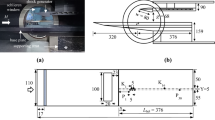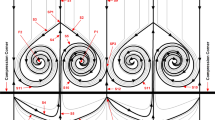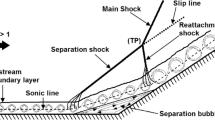Abstract
Transonic shock formation and its coupling to local flow separation and streamwise vortices are considered in three-dimensional internal flow over the first turn of a serpentine diffuser. The present investigations indicate that the shock strength is highest at the diffuser’s spanwise corners, where it locks flow separation to its root, with separation decoupling and gradually being displaced downstream toward the midspan, as the shock progressively weakens spanwise. In addition, two counter-rotating vortices that originate at each corner of the D-shaped diffuser inlet strengthen and become displaced along the flow separation domain envelope as a result of interaction of the corner flow with the shock. Fluidic-based flow control is utilized to directly target flow separation, through which it indirectly controls both the dominant streamwise vortices and shock due to inherent internal flow coupling through the pressure field. It is shown that the flow control expands the central domain of the attached flow toward the edges, thereby confining the shock extent to the corners, while decoupling the joint action of the corner vortices as the vortex pair. In addition, some flow control realizations split the shock footprint into the two consecutive legs, arguably altering the normal shock topology into the lambda shape. Along with changing the shock footprint topology, flow control displaces the streamwise vortex pair farther apart and thereby diminishes the cooperative advection of a low-momentum fluid from the wall region into the core flow, thereby effectively coupling to the long-range alteration of the bulk flow. This global effect on the internal flow was quantified by the overall reduction in the total pressure circumferential nonuniformity by about 30%, associated with 1% reduction in total pressure losses.
Graphic Abstract

















Similar content being viewed by others
References
Asghar A, Stowe RA, Allan WD, Alexander D (2015) Performance evaluation of an S-duct diffuser of a flight-vehicle inlet in high-subsonic flow. In: Proceedings of ASME Turbo Expo 43740
Babinsky H, Harvey JK (2011) Shock wave-boundary-layer interactions. Cambridge University Press, Cambridge
Bell JH, Schairer ET, Hand LA, Mehta RD (2001) Surface pressure measurements using luminescent coatings. Annu Rev Fluid Mech 33(1):155–206
Beresh SJ, Henfling JF, Spillers RW, Pruett BO (2016) Unsteady shock motion in a transonic flow over a wall-mounted hemisphere. AIAA J 54(11):3509–3515
Bruce PJK, Burton DMF, Titchener NA, Babinsky H (2011) Corner effect and separation in transonic channel flows. J Fluid Mech 679:247–262
Burrows TJ, Vukasinovic B, Glezer A (2019a) Control of a transonic shock in a serpentine diffuser using surface fluidic actuation. AIAA Paper 3687
Burrows TJ, Vukasinovic B, Lakebrink MT, Mani M, Glezer A (2019b) Control of flow distortion in offset diffusers using trapped vorticity. Int J Heat Fluid Flow 75:122–134
Burrows TJ, Vukasinovic B, Glezer A, Lakebrink MT, Mani M (2021) Experimental and numerical investigation of active flow control of a serpentine diffuser. AIAA J 59(2):607–620
Crouch JD, Garbaruk A, Magidov D, Travin A (2009) Origin of transonic buffet on aerofoils. J Fluid Mech 628:357–369
Delery JM (1985) Shock wave/turbulent boundary layer interaction and its control. Prog Aerosp Sci 22(4):209–280
Gissen AN, Vukasinovic B, Glezer A, Gogineni S (2013) Active shock control in a transonic flow. AIAA Paper 3116
Gissen AN, Vukasinovic B, Glezer A, Gogineni S, Paul MC, Wittich DJ (2014) Active transonic shock control. AIAA Paper 0942
Gregory JW, Sullivan JP, Raman G, Raghu S (2007) Characterization of the microfluidic oscillator. AIAA J 45:568–576
Hartmann A, Klaas M, Schröder W (2012) Time-resolved stereo PIV measurements of shock–boundary layer interaction on a supercritical airfoil. Exp Fluids 52(3):591–604
Kavandi J, Callis J, Gouterman M, Khalil G, Wright D, Green E, Burns D, McLachlan B (1990) Luminescent barometry in wind tunnels. Rev Sci Instrum 61(11):3340–3347
Klinner J, Hergt A, Grund S, Willert CE (2019) Experimental investigation of shock-induced separation and flow control in a transonic compressor cascade. Exp Fluids 60(6):96
Lakebrink MT, Mani M, Winkler C (2017) Numerical investigation of fluidic oscillator flow control in an s-duct diffuser. AIAA Paper 1455
Liu X, Squire LC (1988) An investigation of shock/boundary-layer interactions on curved surfaces at transonic speeds. J Fluid Mech 187:467–486
Liu T, Campbell BT, Burns SP, Sullivan JP (1997) Temperature- and pressure- sensitive luminescent paints in aerodynamics. Appl Mech Rev 50(4):227–246
Molton P, Dandois J, Lepage A, Brunet V, Bur R (2013) Control of buffet phenomenon on a transonic swept wing. AIAA J 51(4):761–772
Morrida J, Gordeyev S, De Lucca N, Jumper EJ (2017) Shock-related effects on aero-optical environment for hemisphere-on-cylinder turrets at transonic speeds. Appl Opt 56(16):4814–4824
Pearcey HH, Holder DW (1954) Examples of the effects of shock-induced boundary-layer separation in transonic flight. Aeronautical Research Council, p 3510
Peterson JI, Fitzgerald RV (1980) New technique of surface flow visualization based on oxygen quenching of fluorescence. Rev Sci Instrum 51(5):670–671
Raffel M, Willert CE, Scarano F, Kähler CJ, Wereley ST, Kompenhans J (2018) Particle image velocimetry: a practical guide. Springer, New York
Raghu S (2013) Fluidic oscillators for flow control. Exp Fluids 54(2):1455
Sartor F, Losfeld G, Bur R (2012) PIV study on a shock-induced separation in a transonic flow. Exp Fluids 53(3):815–827
Stickan B, Dillinger J, Schewe G (2014) Computational aeroelastic investigation of a transonic limit-cycle-oscillation experiment at a transport aircraft wing model. J Fluid Struct 49:223–241
Wallis RA, Stuart CM (1958) On the control of shock induced boundary layer separation with discrete jets. Aeronautical Research Council Current Paper, p 494
Acknowledgements
This work was supported by ONR, monitored by Dr. Steven Martens.
Author information
Authors and Affiliations
Corresponding author
Additional information
Publisher's Note
Springer Nature remains neutral with regard to jurisdictional claims in published maps and institutional affiliations.
Rights and permissions
About this article
Cite this article
Burrows, T.J., Vukasinovic, B. & Glezer, A. Active control of a 3-D flow separation induced by a transonic shock. Exp Fluids 62, 187 (2021). https://doi.org/10.1007/s00348-021-03280-x
Received:
Revised:
Accepted:
Published:
DOI: https://doi.org/10.1007/s00348-021-03280-x




